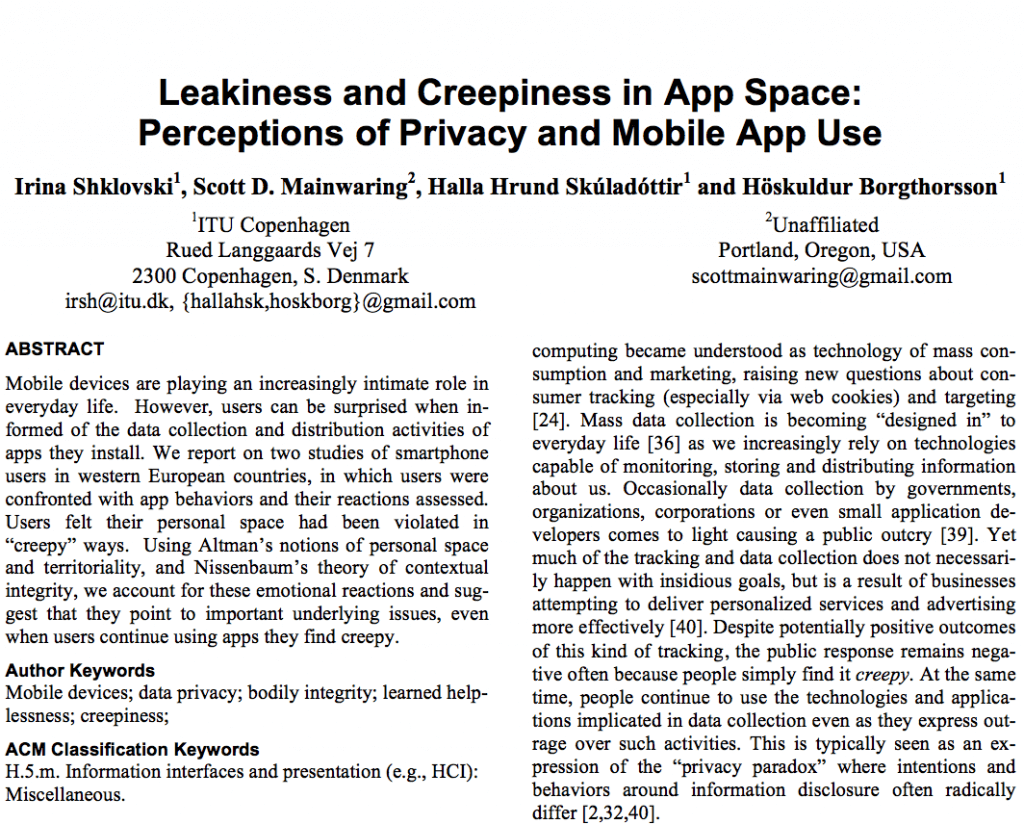I recently had an email exchange with Irina Shklovski in which she kindly sent me the paper she presented at the CHI conference this year. It’s a great paper, with some carefully thought through insights into the data we produce and (often inadvertently) share when using smart phones.
Irina Shklovski, Scott D. Mainwaring, Halla Hrund Skúladóttir, and Höskuldur Borgthorsson. 2014. Leakiness and creepiness in app space: perceptions of privacy and mobile app use. In Proceedings of the 32nd annual ACM conference on Human factors in computing systems (CHI ’14). ACM, New York, NY, USA, 2347–2356.
The paper got me thinking about some broader (and long-standing) issues I’ve been working through myself related to the researcher’s agential (and often inadvertent) role in empirical research. What follows are some slightly amended comments I’ve shared with Irina.

Something that strikes me is that the paper presents a set of examples (dare I say data) about how people make sense of worlds from, if you will, outside of them. I wonder to what extent this is different to how we actually use our mobile devices (how we enact these worlds)? So to what extent are the reflections on talk about privacy, creepiness, leekages, helplessness, etc. insights into how we rationalise what we do as opposed to insights into what we do? I’m not saying this (I hope) to make that well-worn argument about people not doing what they say we do. Nor do I say it to lessen the value of the interviews and survey results presented. I think it’s important though to draw attention to the kind of materials being examined and what can be sensibly said about them.
Here’s one take on the paper, just to try to illustrate this point a bit. The theorising from Altman and Nissenbaum suggest the presumption of some discrete (and somewhat stable) ideas of interior, exterior, private, public, space, etc. etc. Yes, there may be a fluidity to how things move between these categories (and they may change over time), but nevertheless, the implication is there are for all intents and purposes a set of stable, applicable categories. My suggestion isn’t that this is a strong claim, but it does feel like it’s more or less the working assumption in the paper.
In being careful about the kinds of empirical materials being used, I think there’s a different way to think about this. I wonder whether performativity might be a useful concept to work with? Might we say that these things the researchers and the informants collectively spoke about, e.g. selves, data, devices, third parties, privacy etc. are being drawn together to enact just these categories? What we might be seeing here is not an indication of how data falls into (or threads across) these categories, but how we enact them when we talk about our mobile devices and how we make sense of data in those self same terms. (This is one of the ideas I take from Nelson Goodman’s “Ways of Worldmaking” (1978). I love his remark: “The uniformity of nature we marvel at or the unreliability we protest belongs to a world of our own making.” p.10).
Take this statement, for example:
“This is completely ridiculous, I would not invite people into my closet, this is way out of line. No I don’t find it appropriate to give up personal information in exchange for this game and that they don’t need more approval than they apparently do.”
What are the circumstances (discursive and material) that would allow a conversation to unfold in this way and for things like smart phones to be talked about like closets? Moreover, how is it that data on these devices should be understood as personal and in some fashion belonging to the person speaking? I don’t see any of these things to be given. Rather, I want to ask in what way the assemblage of interview, people, devices, data, etc. allow for this kind of talk and enactment of categories like personal, information, right vs. wrong, etc. (I take this argument directly from Helen Verran’s wonderful book, “Science and an African Logic”.
This might seem like an unnecessary theorising, but I think it comes back to the question of the kind of empirical materials presented in the paper and what can be said about them. From the results, I don’t know whether one can really say people have stable ideas of values tied to what’s personal and what’s creepy when it comes to infringements on the personal. I do think what can be usefully asked is ‘How is it that this assemblage of actors/agents allows us to talk about things like private, public, creepiness, leekages, helplessness, etc.?’
Where this becomes concrete, I think, is when we then ask how might things be different? So in what other ways might we talk about these things and what are the possibilities of using matter (or design) to intervene? For instance, how might the data being collected be refigured (discursively and materially) as not personal? What would it take in the design of these systems (and their interfaces) for people to talk about the data being collected as not about them in any intimate way, but about some ‘impersonal’ aggregation of data from a network of nodes? For me this offers the beginnings for thinking differently about data and what it might enable.